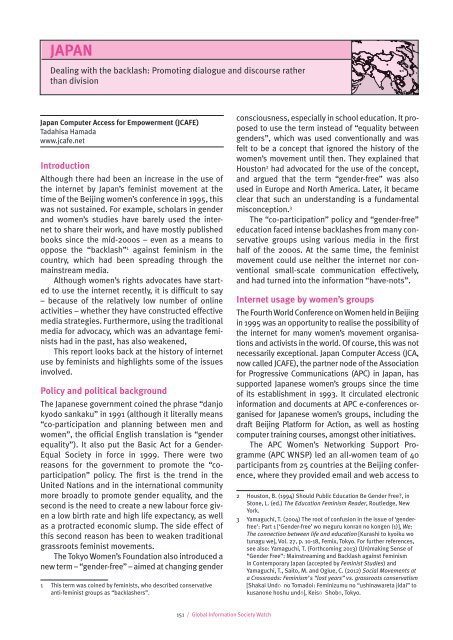gisw13_chapters
gisw13_chapters
gisw13_chapters
You also want an ePaper? Increase the reach of your titles
YUMPU automatically turns print PDFs into web optimized ePapers that Google loves.
japanDealing with the backlash: Promoting dialogue and discourse ratherthan divisionJapan Computer Access for Empowerment (JCAFE)Tadahisa Hamadawww.jcafe.netIntroductionAlthough there had been an increase in the use ofthe internet by Japan’s feminist movement at thetime of the Beijing women’s conference in 1995, thiswas not sustained. For example, scholars in genderand women’s studies have barely used the internetto share their work, and have mostly publishedbooks since the mid-2000s – even as a means tooppose the “backlash” 1 against feminism in thecountry, which had been spreading through themainstream media.Although women’s rights advocates have startedto use the internet recently, it is difficult to say– because of the relatively low number of onlineactivities – whether they have constructed effectivemedia strategies. Furthermore, using the traditionalmedia for advocacy, which was an advantage feministshad in the past, has also weakened,This report looks back at the history of internetuse by feminists and highlights some of the issuesinvolved.Policy and political backgroundThe Japanese government coined the phrase “danjokyodo sankaku” in 1991 (although it literally means“co-participation and planning between men andwomen”, the official English translation is “genderequality”). It also put the Basic Act for a Gender-Equal Society in force in 1999. There were tworeasons for the government to promote the “coparticipation”policy. The first is the trend in theUnited Nations and in the international communitymore broadly to promote gender equality, and thesecond is the need to create a new labour force givena low birth rate and high life expectancy, as wellas a protracted economic slump. The side effect ofthis second reason has been to weaken traditionalgrassroots feminist movements.The Tokyo Women’s Foundation also introduced anew term – “gender-free” – aimed at changing gender1 This term was coined by feminists, who described conservativeanti-feminist groups as “backlashers”.consciousness, especially in school education. It proposedto use the term instead of “equality betweengenders”, which was used conventionally and wasfelt to be a concept that ignored the history of thewomen’s movement until then. They explained thatHouston 2 had advocated for the use of the concept,and argued that the term “gender-free” was alsoused in Europe and North America. Later, it becameclear that such an understanding is a fundamentalmisconception. 3The “co-participation” policy and “gender-free”education faced intense backlashes from many conservativegroups using various media in the firsthalf of the 2000s. At the same time, the feministmovement could use neither the internet nor conventionalsmall-scale communication effectively,and had turned into the information “have-nots”.Internet usage by women’s groupsThe Fourth World Conference on Women held in Beijingin 1995 was an opportunity to realise the possibility ofthe internet for many women’s movement organisationsand activists in the world. Of course, this was notnecessarily exceptional. Japan Computer Access (JCA,now called JCAFE), the partner node of the Associationfor Progressive Communications (APC) in Japan, hassupported Japanese women’s groups since the timeof its establishment in 1993. It circulated electronicinformation and documents at APC e‐conferences organisedfor Japanese women’s groups, including thedraft Beijing Platform for Action, as well as hostingcomputer training courses, amongst other initiatives.The APC Women’s Networking Support Programme(APC WNSP) led an all-women team of 40participants from 25 countries at the Beijing conference,where they provided email and web access to2 Houston, B. (1994) Should Public Education Be Gender Free?, inStone, L. (ed.) The Education Feminism Reader, Routledge, NewYork.3 Yamaguchi, T. (2004) The root of confusion in the issue of ‘genderfree’:Part 1 [‘Gender-free’ wo meguru konran no kongen (1)], We:The connection between life and education [Kurashi to kyoiku wotunagu we], Vol. 27, p. 10-18, Femix, Tokyo. For further references,see also: Yamaguchi, T. (Forthcoming 2013) (Un)making Sense of“Gender Free”: Mainstreaming and Backlash against Feminismin Contemporary Japan (accepted by Feminist Studies) andYamaguchi, T., Saito, M. and Ogiue, C. (2012) Social Movements ata Crossroads: Feminism’s “lost years” vs. grassroots conservatism[Shakai Undō no Tomadoi: Feminizumu no “ushinawareta jidai” tokusanone hoshu undō], Keisō Shobō, Tokyo.151 / Global Information Society Watch


